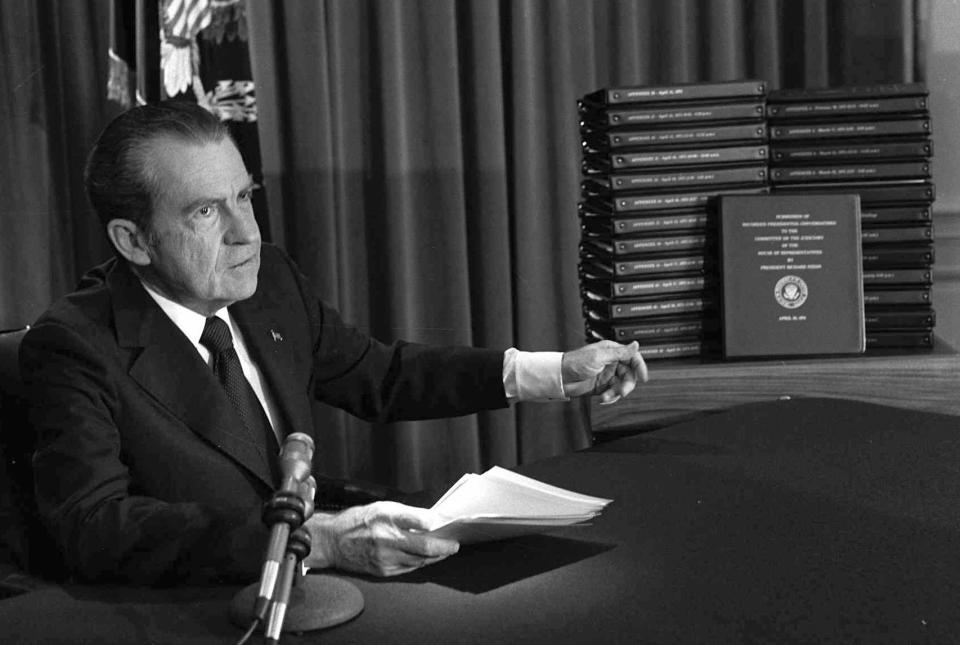Commentary: Why abortion became an issue: In 1972, President Nixon needed it to be one.
- Oops!Something went wrong.Please try again later.
Sunday marked the 50th anniversary of the Roe v. Wade decision. On Jan. 22, 1973, the Supreme Court decided that for the first trimester of a pregnancy, “the attending physician, in consultation with his patient, is free to determine, without regulation by the State, that, in his medical judgment, the patient's pregnancy should be terminated. If that decision is reached, the judgment may be effectuated by an abortion free of interference by the State.”
It went on: “With respect to the State's important and legitimate interest in potential life, the ‘compelling’ point is at viability. This is so because the fetus then presumably has the capability of meaningful life outside the mother's womb. State regulation protective of fetal life after viability thus has both logical and biological justifications. If the State is interested in protecting fetal life after viability, it may go so far as to [prohibit] abortion during that period, except when it is necessary to preserve the life or health of the mother....”
Abortion had been a part of American life since its inception but states began to criminalize abortion in the 1870s. By 1960, an observer estimated, there were between 200,000 and 1.2 million illegal U.S. abortions a year, endangering women, primarily poor ones who could not afford a workaround.
To stem this public health crisis, doctors wanted to decriminalize abortion and keep it between a woman and her doctor. In the 1960s, states began to decriminalize abortion on this medical model, and support for abortion rights grew.
The rising women's movement wanted women to have control over their lives. Its leaders were latecomers to the reproductive rights movement but they came to see reproductive rights as key to self-determination.
In 1971, even the evangelical Southern Baptist Convention agreed that abortion should be legal in some cases, "under such conditions as rape, incest, clear evidence of severe fetal deformity, and carefully ascertained evidence of the likelihood of damage to the emotional, mental, and physical health of the mother.”
By 1972, Gallup pollsters reported that 64% of Americans agreed that abortion should be between a woman and her doctor. Sixty-eight percent of Republicans, who had always liked family planning, agreed, as did 59% of Democrats.
In keeping with that sentiment, in 1973 the Supreme Court, under Republican Chief Justice Warren Burger, in a decision written by Republican Lewis Blackmun, decided Roe v. Wade, legalizing first-trimester abortion.

The common story is that Roe sparked a backlash. But legal scholars Linda Greenhouse and Reva Siegel showed that opposition to the eventual Roe v. Wade decision began in 1972 — the year before the decision — and that it was a deliberate attempt to polarize American politics.
In 1972, President Richard Nixon was up for reelection, and he and his people were paranoid that he would lose. His adviser Pat Buchanan was a Goldwater man who wanted to destroy the popular New Deal state that regulated the economy and protected social welfare and civil rights. To that end, he believed Democrats and traditional Republicans must be kept from power and Nixon must win reelection.
Catholics, who opposed abortion and believed that “the right of innocent human beings to life is sacred,” tended to vote for Democratic candidates. Buchanan, who was a Catholic himself, urged Nixon to woo Catholic Democrats before the 1972 election over the issue of abortion. Although Nixon and Democratic nominee George McGovern had similar stances on abortion, Nixon and Buchanan defined McGovern as the candidate of “Acid, Amnesty, and Abortion,” a radical framing designed to alienate traditionalists.
As Nixon split the U.S. in two to rally voters, his supporters used abortion to stand in for women's rights in general. Railing against the Equal Rights Amendment, in her first statement on abortion in 1972, activist Phyllis Schlafly did not talk about fetuses: “Women’s lib is a total assault on the role of the American woman as wife and mother and on the family as the basic unit of society. Women’s libbers are trying to make wives and mothers unhappy with their career.... They are promoting abortions instead of families.”

A dozen years later, sociologist Kristin Luker discovered that “pro-life” activists believed that selfish “pro-choice” women were denigrating the roles of wife and mother. They wanted an active government to give them rights they didn't need or deserve.
By 1988, radio provocateur Rush Limbaugh demonized women’s rights advocates as “feminazis” for whom “the most important thing in life is ensuring that as many abortions as possible occur.” The complicated issue of abortion had become a proxy for a way to denigrate the political opponents of the radicalizing Republican Party.
Such threats turned out Republican voters, especially the evangelical base. But support for safe and legal abortion has always been strong. Today, notwithstanding that it was overturned in June 2022, 62% of Americans support the guidelines laid down in Roe v. Wade, about the same percentage that supported it 50 years ago, when it became law.
Heather Cox Richardson is an American History professor at Boston College. She wrote this column for her blog, Letters from an American.
This article originally appeared on Palm Beach Post: Abortion an issue when President Nixon needed to win re-election

